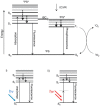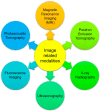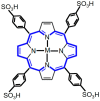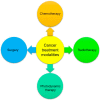Emerging Applications of Porphyrins and Metalloporphyrins in Biomedicine and Diagnostic Magnetic Resonance Imaging
- PMID: 30347683
- PMCID: PMC6316340
- DOI: 10.3390/bios8040095
Emerging Applications of Porphyrins and Metalloporphyrins in Biomedicine and Diagnostic Magnetic Resonance Imaging
Abstract
In recent years, scientific advancements have constantly increased at a significant rate in the field of biomedical science. Keeping this in view, the application of porphyrins and metalloporphyrins in the field of biomedical science is gaining substantial importance. Porphyrins are the most widely studied tetrapyrrole-based compounds because of their important roles in vital biological processes. The cavity of porphyrins containing four pyrrolic nitrogens is well suited for the binding majority of metal ions to form metalloporphyrins. Porphyrins and metalloporphyrins possess peculiar photochemical, photophysical, and photoredox properties which are tunable through structural modifications. Their beneficial photophysical properties, such as the long wavelength of emission and absorption, high singlet oxygen quantum yield, and low in vivo toxicity, have drawn scientists' interest to discover new dimensions in the biomedical field. Applications of porphyrins and metalloporphyrins have been pursued in the perspective of contrast agents for magnetic resonance imaging (MRI), photodynamic therapy (PDT) of cancer, bio-imaging, and other biomedical applications. This review discusses photophysics and the photochemistry of porphyrins and their metal complexes. Secondly, it explains the current developments and mode of action for contrast agents for MRI. Moreover, the application of porphyrin and metalloporphyrin-based molecules as a photosensitizer in PDT of cancer, the mechanism of the generation of reactive oxygen species (ROS), factors that determine the efficiency of PDT, and the developments to improve this technology are delineated. The last part explores the most recent research and developments on metalloporphyrin-based materials in bio-imaging, drug delivery, and the determination of ferrochelatase in bone marrow indicating their prospective clinical applications.
Keywords: bio-imaging; contrast agents; drug delivery; magnetic resonance imaging; metalloporphyrins; photochemistry; photodynamic therapy; photophysics; photosensitizer; porphyrins.
Conflict of interest statement
The authors declare no conflict of interest.
Figures








Similar articles
-
Effect of the nature of the chelated metal on the photodynamic activity of metalloporphyrins.Free Radic Res. 2023 May-Jun;57(6-12):487-499. doi: 10.1080/10715762.2023.2288997. Epub 2023 Dec 26. Free Radic Res. 2023. PMID: 38035627
-
Fullerene-porphyrin nanostructures in photodynamic therapy.Nanomedicine (Lond). 2010 Feb;5(2):307-17. doi: 10.2217/nnm.09.111. Nanomedicine (Lond). 2010. PMID: 20148640 Review.
-
Amphiphilic gemini pyridinium-mediated incorporation of Zn(II)meso-tetrakis(4-carboxyphenyl)porphyrin into water-soluble gold nanoparticles for photodynamic therapy.Colloids Surf B Biointerfaces. 2017 Oct 1;158:602-609. doi: 10.1016/j.colsurfb.2017.07.033. Epub 2017 Jul 18. Colloids Surf B Biointerfaces. 2017. PMID: 28755557
-
Spectroscopic characteristics of metalloporphyrins used in photodynamic therapy.Oftalmologia. 2003;57(2):73-80. Oftalmologia. 2003. PMID: 12974036
-
Application and Challenge of Metalloporphyrin Sensitizers in Noninvasive Dynamic Tumor Therapy.Molecules. 2024 Oct 11;29(20):4828. doi: 10.3390/molecules29204828. Molecules. 2024. PMID: 39459197 Free PMC article. Review.
Cited by
-
Solvent-Driven Self-Organization of Meso-Substituted Porphyrins: Morphological Analysis from Fluorescence Lifetime Imaging Microscopy.Langmuir. 2023 Apr 25;39(16):5727-5737. doi: 10.1021/acs.langmuir.2c03468. Epub 2023 Apr 12. Langmuir. 2023. PMID: 37043283 Free PMC article.
-
Design of a New Catalyst, Manganese(III) Complex, for the Oxidative Degradation of Azo Dye Molecules in Water Using Hydrogen Peroxide.Molecules. 2024 Nov 4;29(21):5217. doi: 10.3390/molecules29215217. Molecules. 2024. PMID: 39519858 Free PMC article.
-
Hemophore-like proteins of the HmuY family in the oral and gut microbiome: unraveling the mystery of their evolution.Microbiol Mol Biol Rev. 2024 Mar 27;88(1):e0013123. doi: 10.1128/mmbr.00131-23. Epub 2024 Feb 2. Microbiol Mol Biol Rev. 2024. PMID: 38305743 Free PMC article. Review.
-
Photosensitizing effects and physicochemical properties of chlorophyll a derivatives with hydrophilic oligoethylene glycol fragments at the macrocycle periphery.Photochem Photobiol Sci. 2024 Mar;23(3):409-420. doi: 10.1007/s43630-023-00527-w. Epub 2024 Feb 6. Photochem Photobiol Sci. 2024. PMID: 38319518
-
UO2 2+-mediated ring contraction of pyrihexaphyrin: synthesis of a contracted expanded porphyrin-uranyl complex.Chem Sci. 2019 Apr 30;10(21):5596-5602. doi: 10.1039/c9sc01593k. eCollection 2019 Jun 7. Chem Sci. 2019. PMID: 31293744 Free PMC article.
References
-
- Valicsek Z., Horváth O. Application of the electronic spectra of porphyrins for analytical purposes: The effects of metal ions and structural distortions. Microchem. J. 2013;107:47–62. doi: 10.1016/j.microc.2012.07.002. - DOI
-
- Valicsek Z., Horváth O., Lendvay G., Kikaš I., Škorić I. Formation, photophysics, and photochemistry of cadmium(II) complexes with 5, 10, 15, 20-tetrakis (4-sulfonatophenyl) porphyrin and its octabromo derivative: The effects of bromination and the axial hydroxo ligand. J. Photochem. Photobiol. A Chem. 2011;218:143–155. doi: 10.1016/j.jphotochem.2010.12.014. - DOI
Publication types
MeSH terms
Substances
LinkOut - more resources
Full Text Sources
Medical

